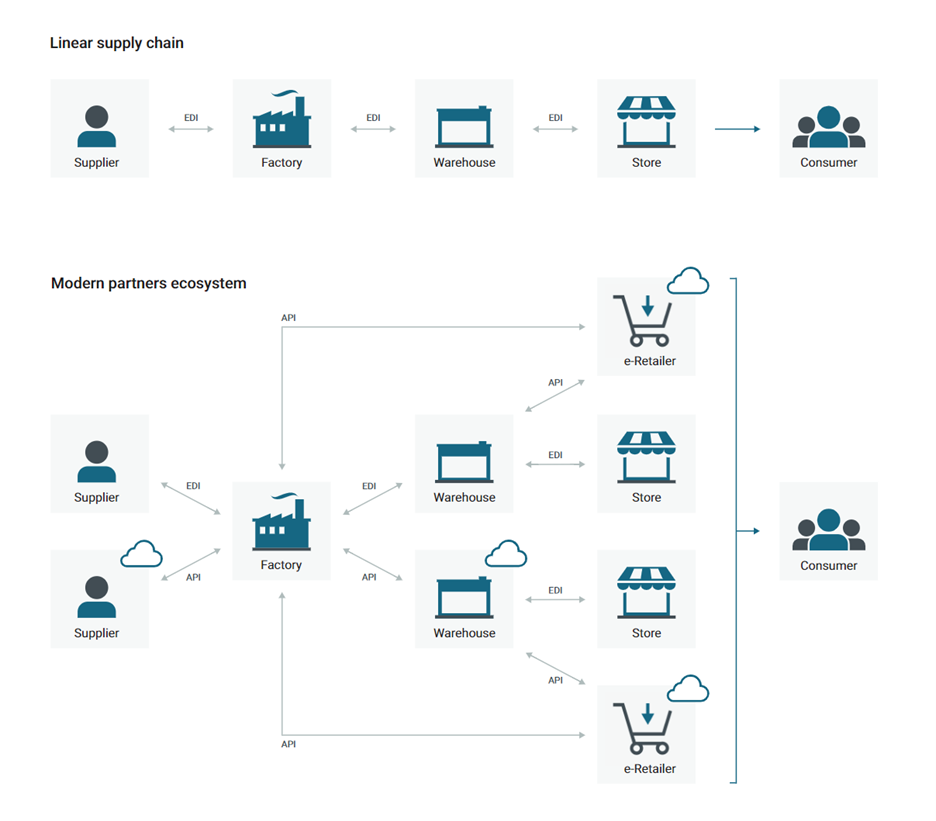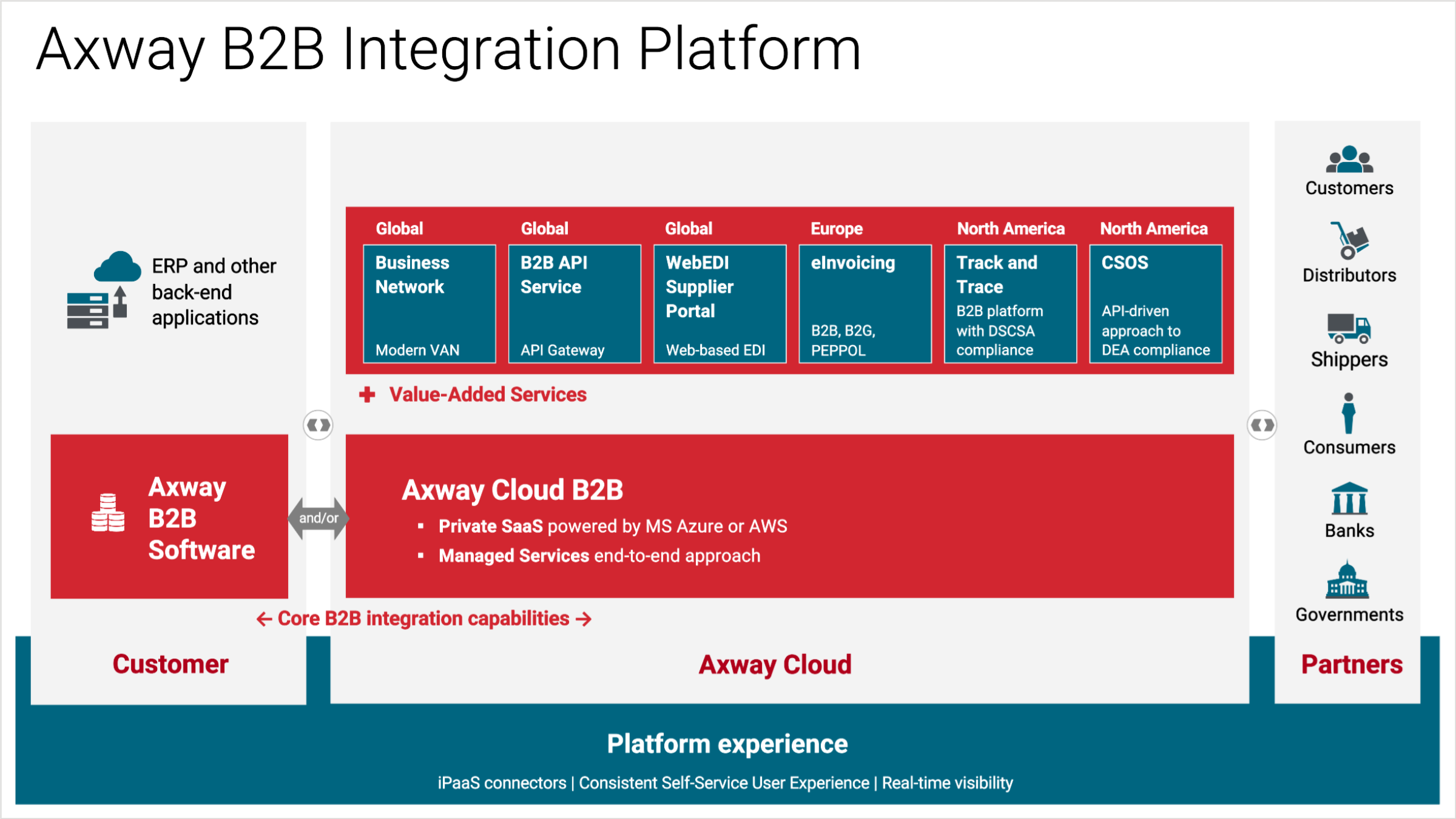Regardless of a business’s products and services, B2B transactions are central to operations — whether communications with suppliers, customers, distributors, or even end consumers. These data transactions can come in the form of purchase orders, invoices, and notices of shipments, to name a few examples.
But these EDI transactions represent only a small part of a B2B integration platform.
What is a B2B integration platform?
At its most basic level, a B2B integration platform is designed to automate key supply chain workflows, allowing two or more businesses to work together more effectively and efficiently – for example, shifting from a linear supply chain workflow to a modern partner ecosystem.
The platform acts as a bridge between disparate technologies that don’t naturally communicate and provides a fast, reliable way for businesses to connect with customers, suppliers, trading partners, and service vendors.
But a modern vision for a B2B integration platform encompasses so much more, and it’s being driven by three major demands in the marketplace today:
- All-in-one integration. Today’s enterprises struggle to unify traditional and modern integration flows. They increasingly want to streamline operations into a central, consistent user experience (UX) – B2B/EDI, API capabilities, iPaaS, compliance, monitoring, e-invoicing, VAN…
- Supply chain resiliency. More than ever before, distributed organizations seek out monitoring and predictability. They want to be able to take quick action during supply chain disruptions. Most importantly, their B2B integration platform must evolve to fit enterprise needs as the market shifts.
- Software that always works. More and more enterprises are getting rid of outdated, inefficient systems for a more modern, scalable, and secure environment. They want to flexibly deploy their B2B integration platform on-premises or in the cloud (leveraging managed services, containerization, and more).
It’s a tall order, but it’s the foundation we at Axway are building to serve B2B needs today and for the future. Here’s a look at the specifics of how a B2B integration platform works, how B2B integrations are evolving, and why B2B is so much more than just EDI flows.
Why are B2B integration platforms a necessity?
In today’s digital-centric world, a B2B integration platform isn’t an advantage; it’s a need. Many businesses are struggling to support a growing number of transactions and navigate evolving security and policy regulations.
They need to ensure convergency with modern cloud-based ERPs and partner ecosystems: a lack of agility in maintaining and onboarding partners can be a showstopper when they can’t effectively answer to new API-driven demands.
Just look at modern supply chains and logistics: we’ve always worked within larger systems of partners, but the EDI and proprietary integrations of the past have evolved into a more streamlined combination of EDI + API-based integrations, for a more interconnected ecosystem.

In a recent webinar, Raghav Jandhyala, Head of Products at Microsoft Dynamics 365 Supply Chain Management, highlighted how important it has become to enhance the resiliency of your supply chain.
See also supply chain resilience: take proactive measures to reduce risk
Consider the types of applications a business uses versus those its vendors use. Odds are there is variance between them, and when that’s the case, they don’t innately talk to each other. The same can be said for the systems the companies use and where various data is stored, whether on premises, in the cloud, or a combination of the two.
All this goes to say that B2B transactions are not simple relationships. With built-in variety from a technology standpoint — and variance in formats, protocols, and security/compliance requirements to address — there must be a way to bridge this gap so businesses can seamlessly exchange data and stay agile for the future.
This approach is especially critical when partners and customers expect speed and reliability that they can’t achieve by relying on legacy B2B integration solutions. While driving automation and more efficient processes, modern B2B integration platforms give businesses a leg up on getting new products and services to the market faster.
They can help stem the constant growth of costs and efforts to maintain traditional EDI infrastructure and adapt modern API-driven solutions in a consistent, seamless manner.
How does a B2B integration platform work?
A B2B integration platform takes data from disparate sources and transforms it into a format that is acceptable on the end of customers, suppliers, partners, and vendors. Classic B2B integration is based on Electronic Data Interchange (EDI), and in fact the two terms have often been used interchangeably in the past.
With EDI, computer-to-computer communication replaced postal mail, fax, and email. But EDI can have its limitations, which is why a modern B2B solution is also API-enabled to allow real-time access and data sharing directly into business applications – allowing you to enforce traditional EDI communication and trade with modern API processes.
Whether it’s a matter of connecting legacy on-premises or modern cloud-based solutions, a B2B integration platform digitizes information in a way that makes data accessible via a single gateway, thus streamlining the flow of data between businesses.
From a process standpoint, we can think of B2B integration this way:
- Data is pulled from a business application via API or another middleware technology and prepared for transmission to external parties.
- Data is automatically translated into an acceptable format (usually EDI), with the relationship between data fields visualized.
- Data is sent to external parties using the appropriate transport protocol based on the sensitivity of the data, file size, and the speed at which the information needs to arrive (among other variables).
- External parties receive and process the data through a target application that allows it to be integrated into core business processes.
- A B2B integration platform layers onto this process centralized visibility, constant monitoring to ensure security and meet SLAs, API integration capabilities, and value-added services like VAN, Web-based EDI, PEPPOL & e-invoicing.
What are some examples of B2B integration in practice?
The easiest way to understand the value of a B2B integration platform is to consider real-world examples of how it fits into business operations and makes a difference.
NEW: [B2B Integration Examples] Benefits of a Modern Platform Approach
Let’s say you’re an automobile manufacturer that deals with multiple suppliers, from tire manufacturers to aluminum material suppliers. As part of these supply chain operations, files like purchase orders and receipts are sent between the businesses on a routine basis. With the help of B2B gateways, this information can be exchanged in a standard format, so it’s easily understood and interpreted by various parties regardless of the systems they use.
Case in point: one major U.S. auto parts distributor uses Axway B2B Integration to enable a highly automated approach to EDI, helping it to identify potential issues rapidly while reducing the need for repetitive management tasks.
This distributor is able to process most client orders with minimal human involvement — freeing employees to focus on strategic planning and helping the organization mitigate the risk of pandemic-related supply chain issues.
Now let’s think about this in the context of a medical product manufacturer with retail providers across the country. Just one of these retailers can have up to 1,500 locations, which translates into thousands of hours of onboarding work for the manufacturer. With a B2B integration platform, the manufacturer can create automated onboarding patterns that save hours of manual work and expedite significant launches.
For example, Cencora operates one of the largest healthcare supply chains in the U.S., partnering with global manufacturers, providers, and pharmacies.
Each day, the company exchanges more than 800,000 EDI messages with more than 23,000 trading partners. Cencora does this by using Axway B2Bi to deliver a scalable, highly available digital front door for all business units — enabling it to rapidly identify and resolve EDI issues and meet demanding service-level agreements.
Cencora is growing rapidly. By centralizing EDI services to a central platform powered by Axway B2Bi, the company has the headroom for continued business expansion.
Where is today’s B2B integration ecosystem headed?
B2B integration started as a means to electronically exchange data between businesses, and while this remains an essential function, their scope has evolved. Alongside saving time and costs, and improving service levels, modern B2B integration platforms strive to create a collaborative ecosystem with partners that drive modern supply chain practices.
Consider self-service capabilities as an example. Designed for scalability, self-service onboarding and enrollment capabilities save significant time for internal teams while giving partners more of the control and convenience they crave in business relationships.
This same level of flexibility should be present from a security and visibility perspective. A modern B2B integration platform should support a wide range of messaging protocols while providing an end-to-end view of business transactions so you can easily monitor issues and improve response times to meet SLAs.
As mentioned earlier, B2B ecosystems are scaling beyond what was previously imaginable. Large organizations need enterprise-grade solutions, and many are now leveraging cloud containers to streamline and secure their B2B integrations while ensuring always-on reliability.
Alongside these factors, as mentioned earlier, today’s B2B integration platforms should also be API-enabled. With greater demands for API connectivity capabilities and the rapid growth that APIs enable, an API-first approach to B2B integration makes it easier to deploy and replicate APIs across ecosystems while delivering a reliable and consistent partner experience.
Finally, as artificial intelligence comes of age, it will continue to drive transformation in the ways businesses interact and exchange data with each other – from verticalization to AI-driven mapping, analytics, or proactive error detection and correction.
Choose Axway as your B2B integration platform
Available as software or managed cloud services, Axway’s API-first B2B Integration Platform modernizes your infrastructure to meet today’s needs — with the flexibility and elasticity to scale for future demands.
Axway’s strategy is to provide our customers with a consistent platform experience that streamlines a great variety of EDI, modern APIs, API-driven VAN, iPaaS connectors, ERP, and cloud-driven flows.

Given the 24/7/365 nature of the B2B integration business, enterprises can’t afford to have problems with EDI and APIs. They need a solution that simply works.
B2B is core to Axway. We have continuously improved data communication and transformation capabilities over the last 20 years, and Axway B2Bi is a high-performing, reliable, scalable solution with a friendly UX.
With broad deployment, management, and cloud options, Axway B2Bi supports partner and community management through self-service features while offering real-time EDI visibility into all applications, so you can anticipate SLA risks and make adjustments as needed. Together, these elements help you respond faster to partners and enable new revenue streams.
Are you prepared for where B2B is headed in the next 10 years? Download this white paper to learn more.


